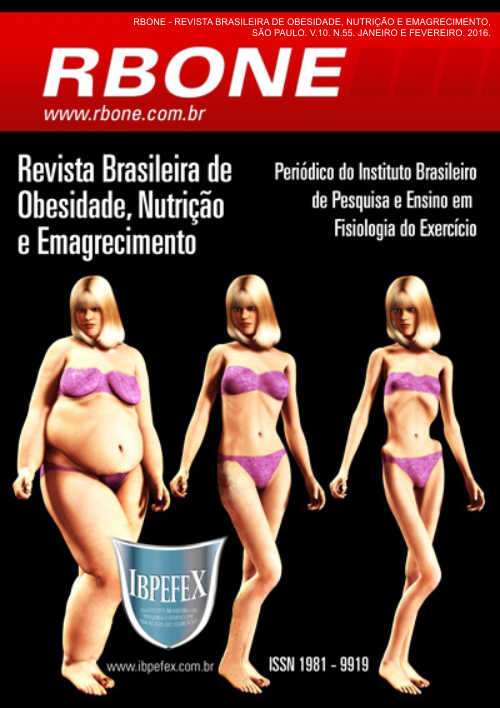Correlation between nutritional state and coronary risk in adults that was attending on educational action in Belém Pará
Abstract
Introduction: Obesity is considered the main risk factor for not transferable chronic diseases development, justifying epidemiological studies. Aims: Know the correlation between nutritional assessment and coronary risk adults attending on educational action inBelém, Pará. Materials and Methods: It was applied treatment record with information like smoking, alcohol consumption, physical activity and pathologies; anthropometric values such high, weight, body mass index (BMI), waist circumference (WC) and neck circumference (NC). Results: The sample was composed of 138 adults, aged between 20 and 59 years old, most women (87%). The nutritional profile from waist circumference shows that 57.97% are at not transferable chronic diseases risk. The neck circumference shows that 70.29% was within the normal. The BMI showed that more than half of the studied population are on overweight (63.77% between overweight and obesity degrees). As to smoking 84.79% the most never smoke, and about alcohol consumption, 64.49% not drink. About the physical activity 64.49% are sedentary. The study showed strong correlation (Pearson) between BMI and WC (r = 0.80) and moderate to BMI and NC (r = 0.57) and between BMI and conicity index (0.37). Conclusion: Most of the valued adults are on note transferable chronic disease risk. The nutritional assessment with BMI shows positive correlation with WC, NC and conicity index, showing that the nutritional assessment influences the coronary risk.
References
-Andriola, E.S.D.; Sousa, M.S.C.; Silva, J.M.F.; Lima, A.L.; Medeiros, R.J.D.; Junior, J.A.D.P.; Araujo, R.F.; Batista, G.R.; Torres, M.S.; Silva, J.M.F.L; Pontes, L.M; Oliveira, L.C. Exposição ao risco cardíaco por referência e perimetria em indivíduos da cidade de João Pessoa. Revista da Faculdade de Educação Física da UNICAMP. Vol. 6. edição especial. p. 272-288. 2008.
-Gigante, D.P.; Dias-da-Costa, J.S.; Olinto, M.T.A.; Menezes, A.M.B.; Macedo, S. Obesidade da população adulta de Pelotas, Rio Grande do Sul, Brasil e associação com o nível socioeconômico. Cadernos de Saúde Pública. Vol. 22. Núm. 9. p. 1873-1879. 2006.
-IDF -International Diabetes Federation: The IDF Consensus Worldwide definition of the metabolic syndrome. 2006.
-Jellife, D. B. Evaluacion del estado de nutrición de la comunidade com especial referencia a las encuestas en las regiones in desarrollo. Ginebra: Organización Mundial de la Salud. 1968.
-Machado, S.P.; Rodrigues, D.G.C.; Viana, K.D.A.L.; Sampaio, H.A.C. Correlação entre o índice de massa corporal e indicadores antropométricos de obesidade abdominal em portadores de Diabetes Mellitus tipo 2. Revista Brasileira de Promoção em Saúde. Vol. 25. Núm. 4. p. 512-520. 2012.
-Mariath, A.B.; Grillo, L.P.; Schmitz, P.; Campos, I.C.; Medina, J.R.P.; Krugger, R.M. Obesidade e fatores de risco para o desenvolvimento de doenças crônicas não transmissíveis entre usuário de unidade de alimentação e nutrição. Caderno de Saúde Pública. Vol. 23. Núm. 4. p. 897-905. 2007.
-Organización Mundial de la salud. El estado físico: uso e interpretación de la antropometria. Ginebra.1995.
-Pitanga, F.J.G. Antropometria na avaliação da obesidade abdominal e risco coronariano. Revista Brasileira de Cineantropometria e Desempenho Humano. Vol. 13. Núm. 3. 2011. p. 238-241.
-Pitanga, F.J.; Lessa, I. Indicadores antropométricos de obesidade como instrumento de triagem para risco coronariano elevado em adultos na cidade de Salvador-Bahia. Arquivo Brasileiro de Cardiologia. Vol. 85. 2005. p. 26-31.
-Pitanga, F.J.G.; Lessa, I. Sensibilidade e especificidade do índice de conicidade como discriminador do risco coronariano de adultos em Salvador, Brasil. Revista Brasileira de Epidemiologia. Vol. 8. Núm. 3. 2004.
-Rezende, F.A.C.; Rosado, L.E.F.P.L.; Ribeiro, R.C.L.; Vidigal, F.C.; Vasques, A.C.J.; Bonard, I.S.; Carvalho, C.R. Índice de massa corporal e circunferência abdominal: Associação com fatores de risco cardiovascular. Arquivo Brasileiro de Cardiologia. Vol. 87. Núm. 6. p. 728-734. 2006.
-Rodrigues, T.F.F.; Philippi, S.T.; Avaliação nutricional e risco cardiovascular em executivos submetidos a check-up. Revista Associação Médica Brasileira. Vol. 54. Núm. 4. 2008. p. 322-7.
-Souza, W.C.; Mascarenhas, L.P.G.; Reiser, F.C.; Souza. W.B.; Lima, V.A.; Muniz, M.A.B.; Grzelczak, M.T. Relação entre o índice de adiposidade corporal, circunferência do pescoço e índice de massa corporal em mulheres sedentárias. Revista Brasileira de Obesidade, Nutrição e Emagrecimento. São Paulo. Vol. 8. Núm. 48. p. 159-164. 2014.
-Tarastchuk, J.C.E.; Guérios, E.E.; Bueno, R.R.C.; Andrade, P.M.P.; Nercolini, D.C.; Ferraz, J.G.G.; Doubrawa, E. Obesidade e intervenção coronariana: Devemos continuar valorizando o Índice de Massa Corpórea? Arquivo Brasileiro de Cardiologia. Vol. 90. Núm. 5. 2008. p. 311-316.
-Vigitel Brasil 2013. Vigilância de fatores de risco e proteção para doenças crônicas por inquérito telefônico. Estimativas sobre frequência e distribuição sociodemográfica de fatores de risco e proteção para doenças crônicas nas capitais dos 26 estados brasileiros e no Distrito Federal em 2013. Brasília-DF. 2014.
-World Health Organization. Obesity: preventing and managing the global epidemic. Geneva. 1997.
Authors who publish in this journal agree to the following terms:
- Authors retain the copyright and grant the journal the right of first publication, with work simultaneously licensed under the Creative Commons Attribution License BY-NC which allows the sharing of the work with acknowledgment of the authorship of the work and initial publication in this journal.
- Authors are authorized to enter into additional contracts separately for non-exclusive distribution of the version of the work published in this journal (eg, publishing in institutional repository or book chapter), with acknowledgment of authorship and initial publication in this journal.
- Authors are allowed and encouraged to post and distribute their work online (eg, in institutional repositories or on their personal page) at any point before or during the editorial process, as this can bring about productive change as well as increase impact and impact. citation of published work (See The Effect of Free Access).






